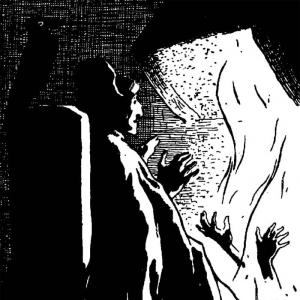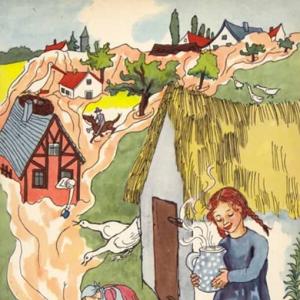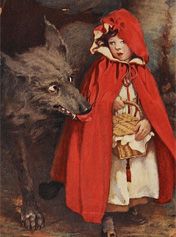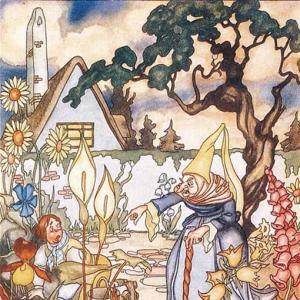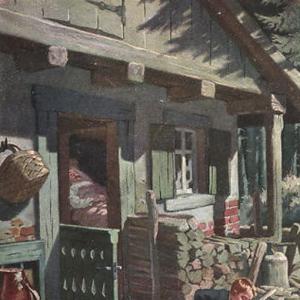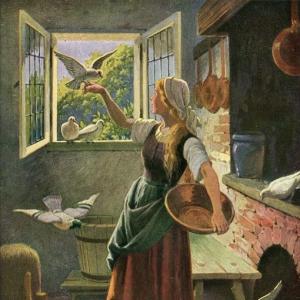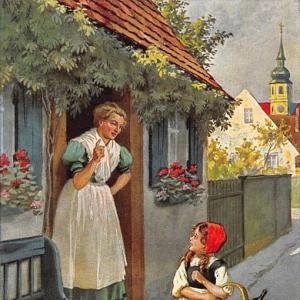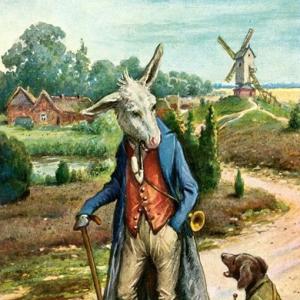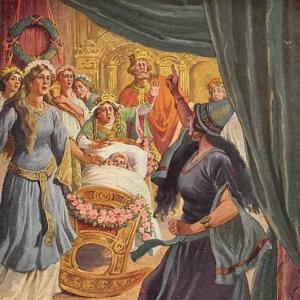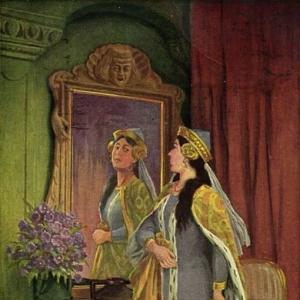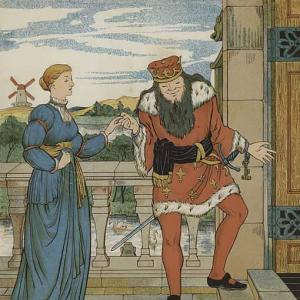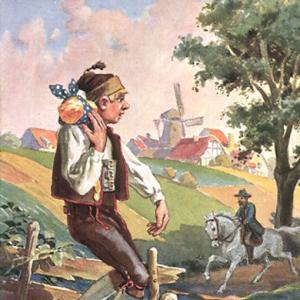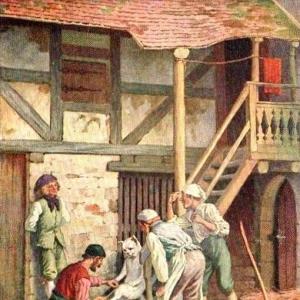Reading time for children: 2 min
A girl from Brakel once went to St. Anne’s Chapel at the foot of the Hinnenberg, and as she wanted to have a husband, and thought there was no one else in the chapel, she sang,
„Oh, holy Saint Anne! Help me soon to a man. Thou know’st him right well,
By Suttmer gate does he dwell,
His hair it is golden,
Thou know’st him right well.“
The clerk, however, was standing behind the altar and heard that, so he cried in a very gruff voice, „Thou shalt not have him! Thou shalt not have him!“ The maiden thought that the child Mary who stood by her mother Anne had called out that to her, and was angry, and cried, „Fiddle de dee, conceited thing, hold your tongue, and let your mother speak!“
 Learn languages. Double-tap on a word.Learn languages in context with Childstories.org and Deepl.com.
Learn languages. Double-tap on a word.Learn languages in context with Childstories.org and Deepl.com.Backgrounds
Interpretations
Adaptions
Summary
Linguistics
„The Maid of Brakel“ is a short fairy tale collected by the Brothers Grimm, who were German cultural researchers and authors known for their work in compiling and publishing a vast collection of European folktales during the 19th century. The Brothers Grimm, Jacob and Wilhelm, aimed to preserve the traditional stories that had been passed down through generations, often by word of mouth. Their collection, known as „Grimm’s Fairy Tales“ or „Children’s and Household Tales,“ was first published in 1812 and has since become a cornerstone of Western literature.
The tale of „The Maid of Brakel“ belongs to this compilation, and like many other tales from the Brothers Grimm, it explores themes of love, marriage, and societal expectations. The story is set in the town of Brakel, a historical town in North Rhine-Westphalia, Germany. St. Anne’s Chapel, where the tale takes place, is a significant location in the story, as it serves as a site of prayer and devotion for the protagonist.
Although the Brothers Grimm collected and published the tale, it is essential to note that they did not create it. Instead, they gathered and recorded stories that were part of the European oral tradition. Consequently, the origins of „The Maid of Brakel“ can be traced back to the cultural and historical context of the communities that told and retold the story over generations.
„The Maid of Brakel“ is a light-hearted fairy tale that can be interpreted in various ways. Here are three possible interpretations:
Role of women in society: This story reflects the societal expectations placed upon women during the time it was written, where their primary goal was to secure a husband and settle down. The girl’s desperation to find a husband indicates the importance of marriage in her life and her perception of its role in her happiness.
Miscommunication and misunderstandings: The tale highlights the consequences of miscommunication and misunderstandings, as the girl mistakes the clerk’s voice for that of the child Mary. This misinterpretation leads to an amusing exchange, demonstrating that assumptions can lead to confusion and misplaced reactions.
Human desires and divine intervention: The story can also be viewed as a commentary on the interplay between human desires and divine intervention. The girl seeks help from St. Anne to find a husband but is met with a response from a human (the clerk) instead. This could suggest that sometimes what people perceive as divine intervention might actually be the result of human actions, implying that people should not solely rely on divine assistance but also take personal responsibility for their choices and actions.
Overall, „The Maid of Brakel“ is an entertaining story that presents various themes and interpretations, inviting readers to consider different aspects of human behavior, societal expectations, and the nature of divine intervention.
„The Maid of Brakel“ is a lesser-known fairy tale from the Brothers Grimm’s collection, but it has still inspired various adaptations and retellings over the years. Here are a few examples.
„The Fairy Cow“ by Edith Nesbit: This is a children’s book adaptation of „The Maid of Brakel,“ which tells the story of a young girl named Margaret who is mistreated by her stepmother and stepsisters. In this version, Margaret encounters a magical cow who helps her with her chores and transforms her life.
„Maggie and the Fairy Cow“ by Andrew Lang: This is another children’s book adaptation of „The Maid of Brakel,“ which follows the story of Maggie, a poor girl who befriends a magical cow. With the cow’s help, Maggie is able to transform her life and gain the respect of her family.
„The Golden Goose“ by the Brothers Grimm: This fairy tale has similarities to „The Maid of Brakel,“ as it follows the story of a young man who is helped by a magical goose. The goose lays golden eggs, which bring him wealth and prosperity.
„Cinderella“ by Charles Perrault: This well-known fairy tale has similarities to „The Maid of Brakel,“ as both stories feature a young girl who is mistreated by her stepmother and stepsisters. In „Cinderella,“ the protagonist is helped by a fairy godmother, who transforms her life and helps her win the heart of a prince.
„Ever After: A Cinderella Story“ (1998): This film adaptation of „Cinderella“ is set in the Renaissance era and stars Drew Barrymore as Danielle, a young woman who is mistreated by her stepmother and stepsisters. Like Margaret in „The Maid of Brakel,“ Danielle is kind and compassionate, which eventually leads to her good fortune.
Overall, „The Maid of Brakel“ has inspired several adaptations and retellings over the years, showcasing the enduring appeal of this lesser-known fairy tale.
In the Brothers Grimm fairy tale „The Maid of Brakel,“ a young girl from the town of Brakel visits St. Anne’s Chapel at the foot of Hinnenberg, hoping to find a husband. Believing she is alone, she sings a prayer to St. Anne, describing her ideal man who lives by the Suttmer gate with golden hair. Unbeknownst to her, the chapel’s clerk is hiding behind the altar and hears her song.
In response, the clerk, imitating a supernatural voice, declares that the girl will not get the man she desires. Mistakenly, the girl assumes that the child Mary, who is depicted next to her mother St. Anne in the chapel, has spoken these words. Annoyed, the girl scolds Mary, telling her to be quiet and allow her mother, St. Anne, to speak instead. This humorous tale highlights the girl’s determination to find a husband and her amusing reaction to an unexpected reply.
A linguistic analysis of „The Maid of Brakel“ by the Brothers Grimm requires examining elements such as language, style, structure, and cultural context.
Here’s a breakdown
Language and Diction: The tale uses simple, direct language characteristic of oral storytelling, making it accessible to a broad audience, including children. The use of colloquial expressions, like „Fiddle de dee,“ reflects informal speech and gives insight into the character’s personality and social background.
Dialogue: The dialogue is crucial for character development and driving the narrative. The girl’s plea is heartfelt and earnest, while the unexpected, gruff response introduces a humorous twist. The contrast between the girl’s polite request and her sassy retort adds humor and illustrates her strong-willed nature.
Rhyme and Rhythm: The girl’s invocation to St. Anne is written in verse, creating a rhythmic and melodic quality. This style is reminiscent of traditional prayers or incantations, emphasizing the girl’s sincerity and desire. The rhyme scheme (AABB) makes the plea memorable and reinforces the oral tradition of fairy tales.
Cultural and Religious Context: The setting at St. Anne’s Chapel and the invocation of saints reflect the cultural and religious influences of the time. St. Anne, known as the mother of the Virgin Mary, is a significant figure in Catholic tradition, symbolizing holy intercession. The reference to „the child Mary who stood by her mother Anne“ aligns with common religious iconography, suggesting the girl’s familiarity with such imagery.
Themes and Motifs: Wishes and prayers, a common motif in fairy tales, highlight the human desire for love and companionship. The tale presents themes of miscommunication and mistaken perception, as the girl misunderstands the source of the voice.
Humor and Irony: The humorous twist arises from the mistaken identity of the voice, with the girl perceiving Mary’s response instead of the clerk’s interjection. The girl’s irreverent response to what she perceives as Mary’s intrusion subverts expectations of reverence in a religious space, adding a layer of irony.
By focusing on these elements, the fairy tale emerges as a playful narrative that captures the whimsy and charm typical of the Brothers Grimm, while also revealing insights into the social and cultural context of the time.
Information for scientific analysis
Fairy tale statistics | Value |
|---|---|
| Number | KHM 139 |
| Aarne-Thompson-Uther-Index | ATU Typ 1476A |
| Translations | DE, EN, DA, ES, FR, PT, IT, JA, NL, PL, RU, TR, VI |
| Readability Index by Björnsson | 22.6 |
| Flesch-Reading-Ease Index | 88.8 |
| Flesch–Kincaid Grade-Level | 5 |
| Gunning Fog Index | 7.3 |
| Coleman–Liau Index | 7.3 |
| SMOG Index | 6.8 |
| Automated Readability Index | 5.4 |
| Character Count | 700 |
| Letter Count | 522 |
| Sentence Count | 8 |
| Word Count | 133 |
| Average Words per Sentence | 16,63 |
| Words with more than 6 letters | 8 |
| Percentage of long words | 6% |
| Number of Syllables | 159 |
| Average Syllables per Word | 1,20 |
| Words with three Syllables | 3 |
| Percentage Words with three Syllables | 2.3% |

